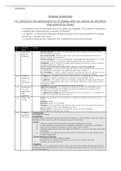01/03/2021
Disease dilemmas
11.1 What are the global patterns of disease and can factors be identified
that determine these?
1.a Diseases can be classified, and their patterns mapped. The spread of diseases is
complex and influenced by a number of factors
1.b There’s a relationship between physical factors and the prevalence of disease
which can change over time
1.c Natural hazards can influence the outbreak and spread of disease
Top Smaller Notes
ic topic
1.a Classifica Zoonotic diseases are infectious diseases like rabies which can be transmitted
tion of from animals to humans
Non communicable: diseases like cancer which are not passed from person to
diseases
person, usually a long duration
Infectious diseases: caused by pathogenic microorganisms like bacteria or viruses,
can spread directly or indirectly between people like TB or Influenza
Contagious: type of infectious disease easily spread by direct or indirect contact
between people like COVID-19
(direct contact like sharing body fluids, indirect contact like coughing)
Communicable: an infectious disease like Malaria transmissible by direct contact,
an individual’s discharge, or by indirect means like a vector.
Non-contagious: require a special mode of transmission between persons such as
vectors or by non-casual transfer of bodily fluid like sharing of needles
1.a Endemic, An endemic is a disease which exists permanently in a geographical area/ group,
epidemic, like sleeping sickness confined to rural areas of sub-Saharan Africa
An epidemic is the sudden outbreak of disease spreading through a population in
and
a restricted geographical area such as the Ebola outbreak in West Africa March
pandemic
2014 killing 25,000
A pandemic is an extensive epidemic such as COVID-19
1.a Degenerat Degenerative diseases are influenced by lifestyle choices like unhealthy diets,
ive and smoking, and drinking, the largest example is cardiovascular disease which
included heart attacks and strokes.
opportuni
An opportunistic disease strikes people whose immune systems are vulnerable as
stic
a result of an existing condition like HIV
diseases
1.a Other key Health: the condition of an individual in relation to physical and mental well-
words being
Mortality: death
Morbidity: being ill or diseased
Pathogen: microorganisms like bacteria and viruses that cause disease. Bacteria
releases toxins, and viruses damage our cells.
Disease vector: the parasite (living thing) which carries a pathogen
(microorganism like bacteria/ virus).
1.a Disease Classification
example: A contagious disease
Distribution
Filariasis
Spreads person to person indirectly by infected mosquitos and blackflies when they take a
bloodmeal from a person with the disease, these act as vectors
Process
1. Mosquito takes blood meal and larvae enter lymphatics (vessels)
2. Larvae changes to adult worms and blocks lymphatics causing skin exfoliation
3. Adult larvae produce microfilariae which enter blood vessels
4. Mosquito takes blood meal and takes microfilaria, as well as inserting larvae into
lymphatics
5. Microfilaria in mosquito become larvae and transfer back into the person when
it takes blood meal.
Current patterns of Filariasis
Currently more than 120million suffer
81countries are endemic for disease, across much of Africa and Asia
1.1billion at risk of infection
Treatment
In 2007, there was a global programme which was the largest public health programme. It
used mass drug administration in form of Diethylcarbamazine (Die-thyl-carbam-azine) to
kill the microfilaria
, 01/03/2021
1.a Global Malaria’s an infectious but non-contagious tropical disease.
distributi Concentrated in Africa, Latin America, and Southeast Asia
on of Cases are concentrated around the equator, as the disease thrives in warm,
humid environments
Malaria
Disease absent in urban areas as public health measures have been effective and
eliminated the disease
1.a Global HIV’s an infectious contagious disease spread by human body fluids like blood
distributi and semen.
The global distribution of disease is uneven, with the main areas of
on of HIV/
concentration being sub-Saharan Africa, specifically Nigeria and South Africa
AIDS
Perhaps the patterns linked to development, however the US has unexpectedly
high cases of HIV
1.a Global An infectious and highly contagious disease associated with poverty and
distributi overcrowded living conditions
Its present in all countries, although 95% of deaths occur in LIDC’s and EDC’s
on of TB
Africa has a large proportion of deaths, with a large proportion being HIV/ AIDS
suffers (an opportunistic disease)
1.a Global A non-communicable disease caused by insulin deficiency
distributi Its widespread among developed and non-developed countries but strongly
concentrated in North America, and South East Asia
on of
More than 25,000,000 have the disease in North America
Diabetes
Type 2 is linked to obesity, poor diet, and physical inactivity
1.a Global Covers range of illnesses like stroke and coronary heart disease
distributi Incidence rises steeply with age, so a major cause or mortality in ageing
populations in high-income countries
on of
Death linked to tobacco consumption, unhealthy diet, and inactivity
Cardiovas
80% of deaths occur in low-and-middle-income countries
cular
disease
(CVD)
1.a Expansion A disease has a source and spreads outwards into new areas
diffusion Meanwhile carriers in source area remain infected
COVID19’s spread by a range of diffusion methods, expansion being one as China
was source, but it spread whilst people in China remained infected
1.a Relocatio When disease leaves origin/ area, moving to new areas
n In Haiti 2010, a cholera epidemic occurred when an earthquake meant aid
workers from Nepal brought the disease as it was endemic in Nepal. It killed
diffusion
7,000.
1.a Contagio Spread through direct contact with carrier, strongly influenced by distance
us However, arguably distance not pivotal due to globalisation
COVID19 is an example
diffusion
1.a Hierarchi Disease spreads through an ordered sequence or classes or places, like from large
cal cities to remote villages
Hierarchical spread can be seen in regard to sexual habits
diffusion
HIV contained among a few carriers with high concurrency of sexual relations.
Disease spread first to those with medium sexual concurrency, then to those
with low sexual concurrency.
(concurrency means happening at same time)
http://thebritishgeographer.weebly.com/the-spread-of-disease-and-its-
management.html#:~:text=Hierarchical%20spread%20involves%20the%20spread,la
rge%20cities%20to%20remote%20villages.




